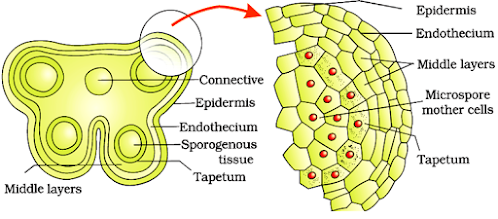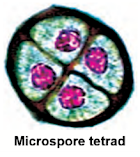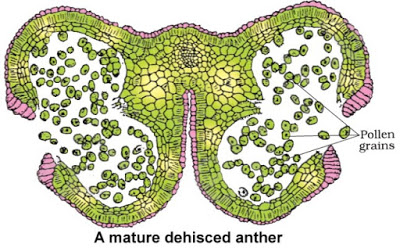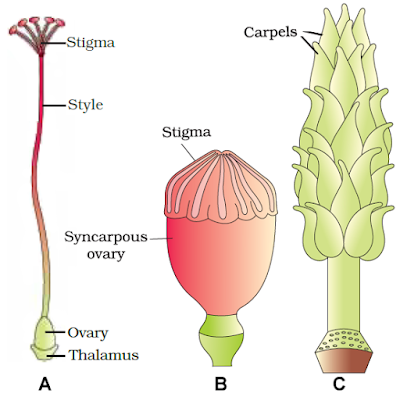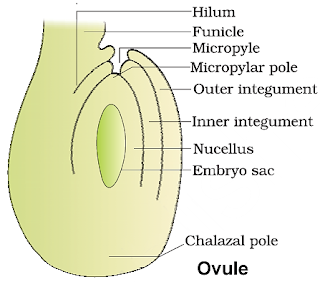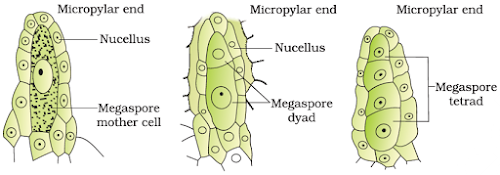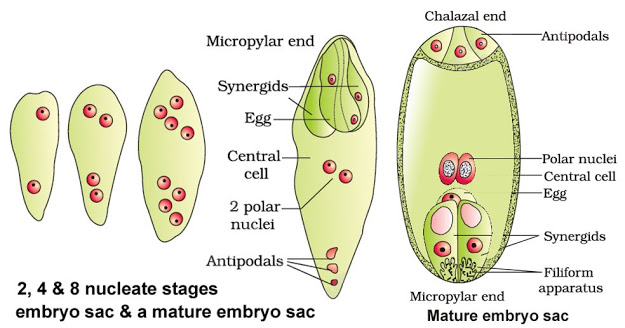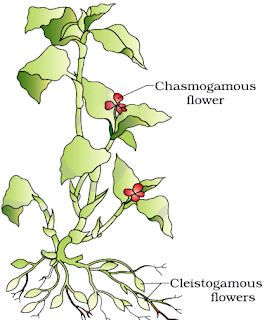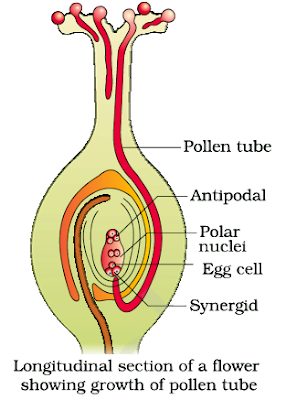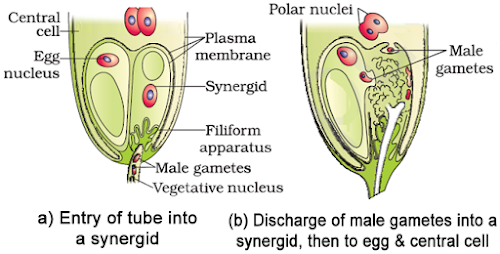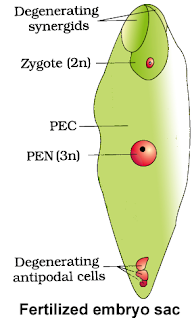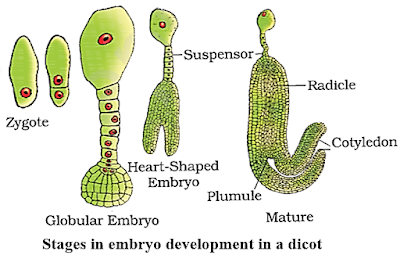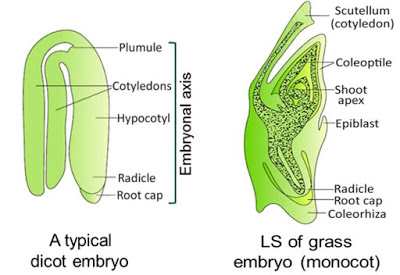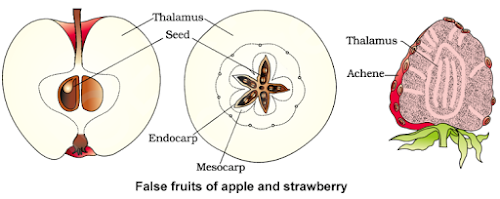Sexual reproduction in flowering plants : Notes and Study Materials -pdf
Notes and Study Materials
- Concepts of Sexual reproduction in flowering plants
- Master File Sexual reproduction in flowering plants
- NCERT Book chapter Sexual reproduction in flowering plants
- NCERT Solutions for – Sexual reproduction in flowering plants
- NCERT Exemplar Solutions for – Sexual reproduction in flowering plants
- Revision Note of Sexual reproduction in flowering plants
- Past Many Years Question papers and Answer of Sexual reproduction in flowering plants
- Mind Map of Sexual reproduction in flowering plants
Examples and Exercise
– The anther is a tetragonal structure consisting of four microsporangia located at the corners (2 in each lobe).
Economic importance of pollen grains:
A. Hibiscus pistil.B. Multicarpellary, syncarpous pistil of Papaver.C. Multicarpellary, apocarpous gynoecium of Michelia
CBSE Class 12th Biology Notes: Sexual Reproduction in Flowering Plants
Each definitions and concept is followed by the solved and unsolved questions. You can also find the various categories questions like short, very short and long answer type.
Have a look on the Highlights of important terminologies and questions:
Microsporogenesis- The process of formation of microspores from a pollen mother cell through meiosis is called microeporogenesis.
Vegetative and Generative Cell-The cytoplasm of pollen grain is mature it contains two cells, the vegetative cell and generative cell. The vegetative cell is bigger, has abundant food revenue and a large irregularly shaped nucleus. The generative cell is small and floats in the cytoplasm of vegetative cell.
The megasporangium (Ovule)- The ovule is a small structure attached to the placenta by means of a stalk called funicle. The body of ovule fuses with funicle.
In the region called hilum. This hylum represents the junction between ovule and funicle. Each ovule has one or two protective envelopes called integuments encircle the ovule except at the tip where a small opening called the micropyle is organised. Opposite the micropyle end, is the chalaza, representing the based part of the ovule.
Megasporogenesis- The process of formation of megaspores from the megaspore mother cell is called megasporogenesis. Ovules generally differentiate a single Megaspore Mother Cell (MMC) is the micropylar region of the nucellus.
Outbreeding Devices-Continued self-pollination result in inbreeding depression. Flowering plant have developed many devices to discourage self-pollination to encourage cross-pollination. In some other species, the anther and stigma are placed at different position. So, that the pollen cannot come in contact with the stigma of the same flowers. Both these devices prevent autogamy. The third device to prevent inbreeding in self in compatibility. In, several species such as Papaya, male and female flowers are present on different plants, that is each plant is either male or female (diocy). This condition prevents both autogamy and geitonogamy.
Artificial Hybridisation-It is one of the major aproaches of crop improvement pragramme. In such crossing experiments it is important to make sure that only the desired pollen grains are used for pollination, and the stigma is protected from contamination. This is achieved by emasculation and bagging techniques.
Embryo- Embryo develops at the micropylar end of the embryo sac where the zygote is situated. Most zygotes divides only after certain amount of endosperm is formed. The zygote gives rise to the proembryo and subsequentlu to the globular heart-shaped and mature embryo.
Parthenocarpu- Parthenocarpq is the formation of fruits without fertilization usually seeds are not produced and hence no new individual is formed. It give rise to seedless fruits e.g.- Pineapple, Banana.
Abomixis-A few flowering plants such as some species Asteraceal, and grasses, have evolved a special mechanism to produce seeds without fertilisation called apomixis.
Poly embryony-In such species each ovule contains many embruos. Occurence of more than one embnjo in a seed is referred as polyembryony.
Pollination-Pollination is the mechanism to achieve this objective. Transfer of pollen grains to the stigma of a pistil is termed pollination :
Kinds of Pollinations=(i) Autogamy -Pollination is achieved within the same flower. Transfer or. pollen grains from the anther to stigma of the same flower.
e.g=Chasmogamous flowers Cleistogamous flowers.
(ii) Geitonogamy- Transfer of pollen grains from the anther to the stigma of another flower of the Same plant.
(iii) Xenogamy- Transfer of pollen grains from anther to the stigma of a different plant. Agent of pollination – (1) Abiotic agencies (2) Biotic agencies
(1) Abiotic agencies
(i) Anemophily – By the wind
(ii) Hydrophily – By the water.
(2) Biotic agencies
(i) Entomophily – By the insects.
(ii) Orhithophily – By the birds.
(iii) Chiropterophily – By the bats.
Very Short Answer Type Questions (1-Mark)
Q. 1. What is double fertilization.
Ans. One male gametes fuses with egg (syngamy) to form zygote. Second male gametes fuses with two polar nuclei to form primary endosperm nucleus. All the steps together represent double fertilization.
Q. 2. Why are cucurbits referred to as monocious.
Ans. It referred to as monocious because in cucurbits male and female flowers are borne on the same plant.
Q. 3. How does the mustard inflorescence differ from banana inflorescence in arrangement? Give the technical term for each.
Ans. In mustard raceme inflorescence is present here, the flowers are borne in acropetal order. In banana spadix inflorescence is present where fleshy axis is enclosed by spathe.
Q.4. In the following figure of a fruit, label the part which is protective in function and that which is responsible for producing new plants.

Ans. Pericarp : Protective in function. Seed is responsible for production new plants.
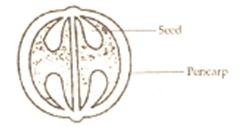
Q. 5. What is the fate of haploid megaspores formed by megaspore mother cell in an angiosperm plant.
Ans. Out of four megaspores formed due to meiosis in megaspore mother cell, usually upper three degenerate and the functional megaspore embryo sac.
Q. 6. Name the type of Pollination taking place in Coconut Palm. List five characteristics of the flowers of coconut plant favouring this type of pollination.
Ans. Type of pollination in coconut plant is Hydrophilly. It is kind of cross pollination carried out by water. Pollen cells from matured anthers drop in water which are carried to ‘stigma of another plant by winds (anemophilly). Fertilisation occurs which results in fruits formation.
Q. 7. Define Parthenocarpy. What are parthenocarpic fruits.
Ans. Parthenocarpy is the formation of fruits without fertilization. The fruits which are formed without fertilization e.g.-seedless fruits of banana.
Short Answer Type Questions (2-Marks)
Q.1. Explain the role of tapetum in the Pollen-grain wall formation.
Ans. It nourishes the developing pollen grains. The tapetal cells provide nourishment to young microspore (amoeboid) or through diffusion parietal or secretory type.
Q. 2. Draw a longitudinal section of a flower showing pollen tube. With their labels.
Ans.
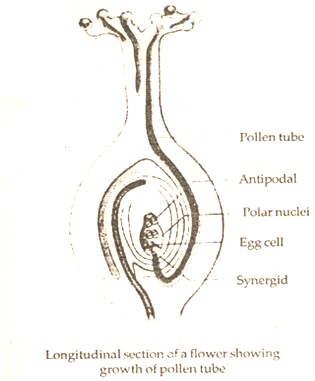
Q. 3. Why do you think, the zygote does not for sometime in a fertilized ovule.
Ans. Zygote start formation of embryo only when certain amount of endosperm is formed . This is an adaptation to provide assured nutrition to the developing embryo .
Q. 4. Define with the draw chasmogamous and cleisto gamous flowers.
Ans.
Chasmogamous flowers | Cleistogamous flowers |
Those flowers which are similar to flowers of other species with exposed anther and stigma. | Those flowers which do not open at all, and the anthers and stigma lie close to each other. |
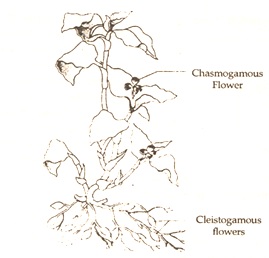
Q. 6. Give a labelled diagram of a typical dicot embryo.
Ans.
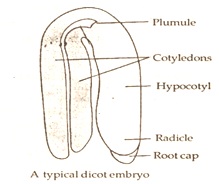
Q. 7. Give a view of microsporangium wall formation with their labells.
Ans.
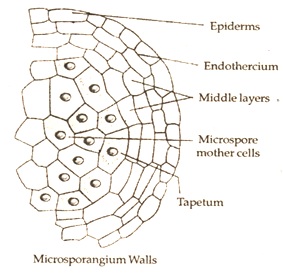
Q. 8. Write the difference between Microsporogenesis and megasporogenesis.
Ans.
Microsporogenesis | Megasporogenesis |
1. This is the formation of microspores in sporogenous tissue due to meiosis. 2. Microspore leads to development of male gametophyte.
|
|
Q. 9. Differentiate between
(i) Hypocotyl and Epicotyl
(ii) Perisperm and Pericarp.
Ans. (i)
Hypocotyl | Epicotyl |
The cylindrical position below the level of cotyledons is called hvpocotyl. | The portion of embryonal axis above the level of cotyledons is called epicotyl. |
(ii)
Perisperm | Peri carp |
It is the residual persistent nucellus. | Covering of fruit. |
Short Answer Type Questions (3-Marks)
Q. 1. Write the differences between self-pollination and cross pollination.
Ans.
Self Pollination | Cross Pollination |
1. It is migration of pollen grains from anther to the stigma of the same flower. 2. Self-pollination always occur through touch or wind. 3. Both anthers and stigmas matures at the same time. 4. It can occur in closed flower homozygous. 5. It preserves the parental characters. Origin of new species is not possible. | 1. It is migration of pollen grains from anther to the stigma of another flower of anther plants. 2. It always occurs through an external agents e.g. air, wind, insects. 3. The anthers and stigmas mature at different time. 4. It can occur in open flower and it always heterozygous. 5. It does not preserve the parental characters, produces new races and varieties. |
Q. 2. Define wind pollination, Write their significant with draw.
Ans. Pollination brought about through the agency of wind in plants.
Significance-
(i) They are devoid of scent, necter etc.
(ii) The pollen grains are dry and unwettable.
(iii) To catch the pollen grains, the stigma becomes stick)” hairy, feathery or branched.
Anemophilous flower (wind pollinated flower) usually bear single ovule in each ovary.
e.g. Coconut palm, Date palm, Cannabis, Zea mays, Grasses.
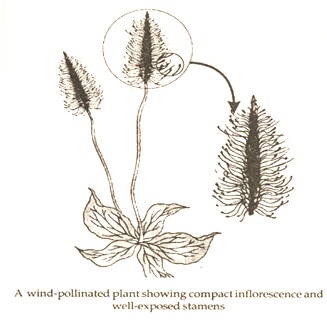
Long Answer Type Questions (5-Marks)
Q. 1. (a) How do the male gametes that are present in the pollen grains reach the site mentioned by you in part (a) to cause double fertilization ?
(b) Draw a longitudinal sectional view of a typical anatropus ovule to show the site where double fertilization. takes place. Lable any four major parts of the ovule.
Ans. (a) The pollen tube releases the male gametes into the cytoplasm of the synergid. The fusion of three haploid nuclei it is termed triple fusion and in it is two types of fusions, syngamy and triple fusion lake is an embryo sac the phenomenon is termed double fertilisation.
(b) In Embryo sac double fertilization takes place.
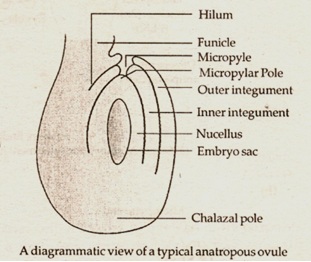
Q. 2. (a) Describe the stages in embryo development in a dicot plant.
(b) Draw a schematic labelled diagram of a fertilised embryo sac of an Angiosperm.
Ans. (a) Embryo develops at the micropylar end of the embryo sac where the zygote is situated. Most zygotes divide only after certain amount of endosperm is formed. This adaptation provide assured nutrition to the dezeloping embryo the large stages of Embryo development (embryogeny) are similar in monocotyledons and dicotyledone.
The stages of embryogeny in a dicotyledonous embryo. The zygote gives rise to the preembryo and subsequently to the globular, heart-shaped and mature embryo.
In the dicot stem the embryo consists of an embryonal axis, two cotyledons, Plumule, radical or root tip. The root tip is covered with root cap.

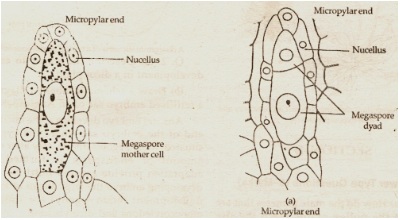
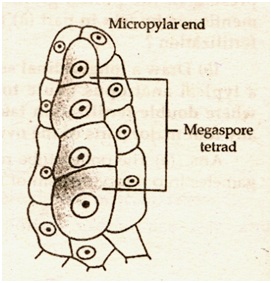
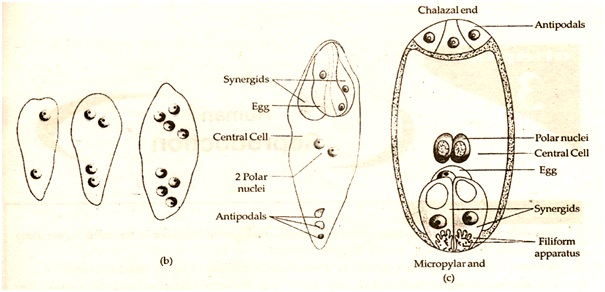
Part of the ovule showing a large megaspore mother cell, a dyad and a tetrad of megaspores; (b) 2/ 4 and 8-nucleate stages of embryo sac and a mature embryo sac; (c) A diagrammatic representation of the mature embryo sac.
Sexual Reproduction in Flowering Plants Class 12 Biology MCQs
1. How many microspore mother cells are required to produce 1000 microspores/pollen grains?
(a) 100
(b) 150
(c) 200
(d) 250
Answer
Answer: d
2. Which of the following represents the female gametophyte in angiosperms?
(a) Embryo
(b) Embryo sac
(c) Synergid
(d) Endosperm
Answer
Answer: b
3. In a breeding experiment, the selected male parent is diploid and the female parent is tetraploid. What will be the ploidy level of the endosperm that will develop after double fertilisation?
(a) Diploid
(b) Triploid
(c) Tetraploid
(d) Pentaploid
Answer
Answer: d
4. The development of fruits without fertilisation of the ovary, is called
(a) parthenogenesis
(b) parthenocarpy
(c) agamospermy
(d) apomixis
Answer
Answer: b
5. When the pollen of a flower is transferred to the stigma of another flower on the same plant, the process is known as
(a) autogamy
(b) geitonogamy
(c) xenogamy
(d) cleistogamy
Answer
Answer: b
6. The number of meiotic divisions, required to produce 400 seeds in a pea plant, is
(a) 100
(b) 200
(c) 400
(d) 500
Answer
Answer: d
7. A dicotyledonous plant bears flowers but never produces fruits and seeds. The most probable cause for the above situation is [NCERT Exemplar]
(a) plant is dioecious and bears only pistillate flowers.
(b) plant is dioecious and bears both pistillate and staminate flowers.
(c) plant is monoecious.
(d) plant is dioecious and bears only staminate flowers.
Answer
Answer: d
8. Autogamy can occur in a chasmogamous flower if [NCERT Exemplar]
(a) pollen matures before maturity of ovule.
(b) ovules mature before maturity of pollen.
(c) both pollen and ovules mature simultaneously.
(d) both anther and stigma are of equal lengths.
Answer
Answer: c
9. Choose the correct statement from the following. [NCERT Exemplar]
(a) Cleistogamous flowers always exhibit autogamy.
(b) Chasmogamous flowers always exhibit geitonogamy.
(c) Cleistogamous flowers exhibit both autogamy and geitonogamy.
(d) Chasmogamous flowers never exhibit autogamy.
Answer
Answer: a
10. From among the situations given below, choose the one that prevents both autogamy and geitonogamy. [NCERT Exemplar]
(a) Monoecious plant bearing unisexual flowers.
(b) Dioecious plant bearing only male or female flowers.
(c) Monoecious plant with bisexual flowers.
(d) Dioecious plant with bisexual flowers.
Answer
Answer: b
11. In a fertilised embryo sac, the haploid, diploid and triploid structures are: [NCERT Exemplar]
(a) Synergid, zygote and primary endosperm nucleus.
(b) Synergid, antipodal and polar nuclei.
(c) Antipodal, synergid and primary endosperm nucleus.
(d) Synergid, polar nuclei and zygote.
Answer
Answer: a
12. In an embryo sac, the cells that degenerate after fertilisation are: [NCERT Exemplar]
(a) Synergids and primary endosperm cell.
(b) Synergids and antipodals.
(c) Antipodals and primary endosperm cell.
(d) Egg and antipodals.
Answer
Answer: b
13. Which of the following floral parts forms the pericarp after fertilisation?
(a) Nucellus
(b) Outer integument
(c) Ovary wall
(d) Inner integument
Answer
Answer: c
14. The stalk of the ovule is called _____ .
Answer/Explanation
Answer:
Explaination: Funicle.
15. The outer integument of the ovule develops into _____ after fertilisation.
Answer/Explanation
Answer:
Explaination: Testa.
16. The exine of pollen grains is made up of ______ .
Answer/Explanation
Answer:
Explaination: Sporopollenin.
17. The outermost layer of endosperm in a maize grain is known as ______ .
Answer/Explanation
Answer:
Explaination: Aleurone layer.
18. A bisexual flower that never opens, is called ______ .
Answer/Explanation
Answer:
Explaination: Cleistogamous.
19. In the grass family, the single cotyledon is called ______ .
Answer/Explanation
Answer:
Explaination: Scutellum.
20. The hollow foliar structure that encloses the leaf primordia in a grass embryo, is called ______ .
Answer/Explanation
Answer:
Explaination: Coleoptile
21. In apple, the ______ also contributes to fruit formation and becomes edible.
Answer/Explanation
Answer:
Explaination: Thalamu
22. Occurrence of more than one embryo in a seed, is known as ______ .
Answer/Explanation
Answer:
Explaination: Polyemb
23. Dehydration and _____ of mature seeds are crucial for storage of seeds.
Answer/Explanation
Answer:
Explaination: Dormancy.
24. Match the terms in Column I with the descriptions in Column II.
| Column I | Column II |
| A. Pericarp | 1. Cotyledon in the seeds of grasses. |
| B. Pollen grains of Vallisneria | 2. Remains of nucellus in a seed. |
| C. Perisperm | 3. Mucilaginous covering. |
| D. Scutellum | 4. Wall of the true fruit. |
Answer/Explanation
Answer:
Explaination: A – 4, B – 3, C – 2, D – 1
25. Match the terms in Column I with the descriptions in Column II.
| Column I | Column II |
| A. Syncarpous ovary | 1. Occurrence of more than one embryo in a seed. |
| B. Polyembryony | 2. Carpels in a flower are fused together. |
| C. Apomixis | 3. Removal of Stamens from the bisexual flower bud. |
| D. Emasculation | 4. Formation of seeds without fertilisation. |
| 5. Development of ovary into fruit without fertilisation. |
Answer/Explanation
Answer:
Explaination: A – 2, B – 1, C – 4, D – 3
26. Sepals and petals orperianth are inconspicuous in entomophilous flowers. [True/False]
Answer/Explanation
Answer:
Explaination: False.
27. In Zostera, the pollen grains are long and ribbon-like and released inside the water. [True/False]
Answer/Explanation
Answer:
Explaination: True.
28. Embryo sac → Nucellus → Integuments, is the correct sequence of parts in the ovule of an angiosperms. [True/False]
Answer/Explanation
Answer:
Explaination: True.
29. Conidia are formed endogenously while zoospores are formed endogenously. [True/False]
Answer/Explanation
Answer:
Explaination: False.
30. Meiosis does not occur in the organisms showing haplontic life cycle. [True/False]
Answer/Explanation
Answer:
Explaination: False.
Directions (Q31 to Q35): Mark the odd one in each of the following groups.
31. Antipodal cells, Synergids, Zygote, Female gamete
Answer/Explanation
Answer:
Explaination: Zygote.
32. Zygote, Endosperm, Embryo, Persperm
Answer/Explanation
Answer:
Explaination: Endosperm.
33. Radicle, Plumule, Endosperm, Scutellum
Answer/Explanation
Answer:
Explaination: Endosperm.
34. Mango, Apple, Strawberry, Cashew
Answer/Explanation
Answer:
Explaination: Mango.
35. Epidermis, Endothecium, Middle layers, Sporogenous tissue.
Answer/Explanation
Answer:
Explaination: Sporogenous tissue.
36. How many microsporangia are present in a typical anther of an ar.giosperm? [Foreign 2013]
Answer/Explanation
Answer:
Explaination: Four microsporangia.
37. Name the innermost and outermost wall layers of a microsporangium in an angiosperm anther. [Foreign 2013]
Answer/Explanation
Answer:
Explaination: Tapetum is the innermost.
Epidermis is the outermost.
38. An anther with malfunctioning tapetum often fails to produce viable male gametophyte. Give any one reason. [Delhi 2013,10; HOTS]
Answer/Explanation
Answer:
Explaination: Since the tapetum nourishes the developing pollen grains, their development is impaired.
39. How many microspore mother cells would be required to produce one hundred pollen grains in a pollen sac? And why? [Foreign 2013]
Answer/Explanation
Answer:
Explaination: Twenty five microspore mother cells. Each microspore mother cell undergoes meiosis and forms four microspores.
40. AbilobeddithecousantherhaslOOmicrospore mother cells per microsporangium. How many male gametophytes can this anther produce? [Delhi 2010; HOTS]
Answer/Explanation
Answer:
Explaination: 1600 male gametophytes.
41. What are germ pores?
Answer/Explanation
Answer:
Explaination: Germ pores are those places on the exine of a pollen grain, where sporopollenin is thin or absent and gives the appearance of an aperture.
42. Give an example of a plant which came into India as a contaminant and is a cause of pollen allergy. [AI 2014]
Answer/Explanation
Answer:
Explaination: Parthenium (Carrot grass).
43. Mention two environmental factors that affect pollen viability. [Delhi 2011C]
Answer/Explanation
Answer:
Explaination: Temperature and humidity.
44. How are different varieties of pollen grains stored for long period of time in pollen banks? [AI 2017C]
or
Mention any one application of a pollen bank [Delhi 2011C]
Answer/Explanation
Answer:
Explaination: The pollen grains can be stored for years in liquid nitrogen (-196 °C) in pollen banks and used for crop breeding programmes.
45.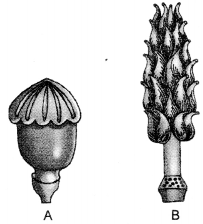
These pictures show the gynoecium of (A) Papaver and (B) Michelia flowers.
Write the difference in the structure of their ovaries. [Delhi 2015C]
Answer/Explanation
Answer:
Explaination: – In (A) Papaver, the ovary is syncarpous, where the carpels are fused together.
– In (B) Michelia, the ovary is apocarpous, where the carpels remain free from one another.
46. What represents the (a) basal part and (b) female gametophyte of the ovule?
Answer/Explanation
Answer:
Explaination: (a) Chalaza represents the basal part and
(b) embryo sac, the female gametophyte.
47. How many megaspore mother cell(s) become(s) differentiated in an ovule?
Answer/Explanation
Answer:
Explaination: Only one megaspore mother cell becomes differentiated in an ovule.
48. When does cell wall formation start, in the organisation of the embryo sac?
Answer/Explanation
Answer:
Explaination: At the eight-nucleate stage.
49. Of the eight nuclei formed in the em bryo sac, six become organised into cells.
(a) What term is given to the other two nuclei?
(b) Name the cell in which they are present.
Answer/Explanation
Answer:
Explaination: (a) The other two nuclei are called polar nuclei.
(b) They are present in the central cell.
50. What is filiform apparatus?
Answer/Explanation
Answer:
Explaination: Filiform apparatus refers to the special cellular thickenings in the synergids, towards micropylar tip.
51. State the function of filiform apparatus found in mature embryo sac of an angiosperm. [Foreign 2014]
Answer/Explanation
Answer:
Explaination: They play an important role in guiding the pollen tube to enter one of the synergids.
52. Describe the structure of the cell (s) that guide (s) the pollen tube to enter the embryo sac. [AI 2014C]
Answer/Explanation
Answer:
Explaination: The synergids have filiform apparatus, the special cellular thickenings at the micropylar tip.
53. State the significance of pollination.
Answer/Explanation
Answer:
Explaination: Pollination brings the carrier of male gametes, i.e. pollen to the stigma of the pistil.
54. Why are cleistogamous flowers invariably autogamous?
Answer/Explanation
Answer:
Explaination: Cleistogamous flowers are the bisexual flowers which do not open at all even at maturity and their stamens and stigma are never exposed for xenogamy or geitonogamy; the anthers and stigma lie close to each other and self pollination is effected easily.
55. How is it possible in Oxalis and Viola plants to produce assured seed-sets even in the absence of pollinators? [Foreign 2012: HOTS]
Or
Pea flowers produce assured seed-sets. Give a reason. [AI 2010; HOTS]
Answer/Explanation
Answer:
Explaination: Oxalis and Viola or pea produce cleistogamous flowers, in which anthers and stigma lie close to each other; when the anthers dehisce in the flower buds, the pollen grains fall on the stigma and fertilization is effected leading to assured seed-set.
56. Give the technical term for the type of pollination
(a) which ensures genetic recombination.
(b) between different flowers of the same plant
Answer/Explanation
Answer:
Explaination: (a) Xenogamy.
(b) Geitonogamy.
57. The following statements describe the wind-pollinated plants. Which one of these statements is incorrect? [CBSE Sample Paper 2013]
(a) The pollen grains are sticky.
(b) Stamens are well-exposed.
(c) Flowers often have single ovule.
Answer/Explanation
Answer:
Explaination: (a) The pollen grains are sticky.
58. Mention the pollinating agent of an inflorescence of small dull-coloured flowers with well-exposed stamens and large feathery stigmas. Give any one characteristic of pollen grains produced by such flowers.
Answer/Explanation
Answer:
Explaination: – Wind is the pollinating agent.
– The pollen grains are light and non- sticky/dry.
59. Name the part of the flower, which the tassels of the com cob represent. [A t 2014]
Answer/Explanation
Answer:
Explaination: Styles and stigmas.
60. Why do com cobs have long tassels? [AI 2010C; HOTS]
Answer/Explanation
Answer:
Explaination: The long tassels of com cob are the styles and stigmas; they are meant to easily trap the air-bome pollen grains.
61. Name two groups of plants where water is the medium for transport of male gametes. [AI 2010C; HOTS]
Answer/Explanation
Answer:
Explaination: Bryophytes and pteridophytes.
62. How do the pollen grains of Vallisneria protect themselves? [AI 2012]
Answer/Explanation
Answer:
Explaination: Pollen grains of Vallisneria are protected from wetting by the mucilaginous covering.
63. The following statements (i), (ii) and (iii) . seem to describe the water-pollinated submerged plants. Which one of these statements is incorrect?
(i) The flowers do not produce nectar.
(ii) The pollen grains have mucilaginous covering.
(iii) The brightly-coloured female flowers have long stalks to reach the surface.
Answer/Explanation
Answer:
Explaination: (iii) is incorrect.
64. How do flowers of Vallisneria get pollinated? [Foreign 2013]
Answer/Explanation
Answer:
Explaination: Vallisneria shows true hydrophily, i.e. pollination by water.
65. Why do the pollen grains of Vallisneria have a mucilaginous covering?[Delhi 2010C; HOTS]
Answer/Explanation
Answer:
Explaination: The mucilaginous covering protects the pollen grains from wetting and the consequent decay.
66. Mention the pollinating agents for aquatic plants, Vallisneria and water lily, respectively. [AI 2010C]
Answer/Explanation
Answer:
Explaination: Vallisneria is pollinated by water and water lily is pollinated by insects.
67. What are nectar/pollen robbers?
Answer/Explanation
Answer:
Explaination: Nectar/pollen robbers are those floral visitors which consume pollen or nectar without bringing about pollination.
68. What is meant by ‘self-pollen’?
Answer/Explanation
Answer:
Explaination: ‘Self-pollen’ means the pollen grains from the same flower (as of the stigma) or pollen from other flowers of the same plant.
69. How is fertilisation by a self-incompatible pollen prevented?
Answer/Explanation
Answer:
Explaination: Fertilisation by a self-incompatible pollen is prevented by:
(a) inhibiting the germination of the pollen.
(b) retarding the growth of the pollen tube.
70. What is pollen-pistil interaction and how is it mediated? [Foreign 2014]
Answer/Explanation
Answer:
Explaination: – All those events from the deposition of pollen on the stigma till the entry of pollen tube into the ovule, are collectively referred to as pollen-pistil interaction.
– It is mediated by the interaction of chemicals secreted by the pollen and the stigma.
71. The meiocyte of rice has 24 chromosomes.
Write the number of chromosomes in its endosperm. [Delhi 2013C; HOTS]
Answer/Explanation
Answer:
Explaination: 36 chromosomes.
72. What happens to the endospenn in seeds like castor?
Answer/Explanation
Answer:
Explaination: It is used by the embryo for nutrition during seed germination.
73. Fill in the blanks a and b
Zygote → a → Globular embryo → b → Mature embryo.
Answer/Explanation
Answer:
Explaination: (a) Proembryo
(b) Heart-shaped embryo
74. Identify ‘A’ in the figure showing a stage of embryonic development in a dicot plant and mention its function. [AI 2016C]
Answer/Explanation
Answer:
Explaination: ‘A’ represents the cotyledons.
– Cotyledons have reserve food materials that are used by the embryo during germination of the seed.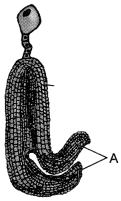
75. Mention the common function that cotyledons and nucellus perform.
Or
Mention the common function that endosperm and perisperm perform.
Answer/Explanation
Answer:
Explaination: They help in the nourishment of the embryo, with the reserve food materials stored in them.
76. Name the part of the flower that contributes to fruit fonnation in strawberry and guava respectively.
Answer/Explanation
Answer:
Explaination: Thalamus in strawberry and ovary in guava.
77. Why is banana referred to as a parthenocarpic fruit? [AI 2013C]
Or
Why is banana considered a good example of parthenocarpy? [AI 2012; HOTS]
Answer/Explanation
Answer:
Explaination: Banana fruit develops without fertilisation of the ovary; hence it is considered parthenocarpic.
78. Banana produces fruits, but is propagated only by vegetative means. Why is it so? [Foreign 2012: HOTS]
Answer/Explanation
Answer:
Explaination: – Banana produces fruit without fertilization of ovary; the process is known as parthenocarpy.
– Since, parthenocarpic fruits are seedless or the seeds are non-viable, banana is propagated by vegetative means.
79. Given below is a section of a maize grain. Identify ‘A’ and state its function.[AI 2016C]
Answer/Explanation
Answer:
Explaination: ‘A’ represents the endosperm.
– It stores food materials, which are used by the embryo during seed germination.
80. Mention two advantages of seeds to man,
Answer/Explanation
Answer:
Explaination: Two advantages of seeds to man:
(i) Seeds are stored and used as food.
(ii) They are used to raise the crop.
81. How does a farmer use the dormancy of seeds to his advantage?
Answer/Explanation
Answer:
Explaination: Dormancy and dehydration are crucial for storage of seeds; the farmer dehydrates the dormant seeds and stores the seeds for raising a new crop in the next season.
82. Name the seeds that have retained their viability for thousands of years.
Answer/Explanation
Answer:
Explaination: Lupinus arcticus and Phoenix dactylifera.
83. Name two parasitic species of plants that produce many minute seeds in a fruit.
Answer/Explanation
Answer:
Explaination: Orobanche and Striga.
84. Name the mechanism responsible for the formation of seed without fertilisation in angiosperms. Give an example of a species of flowering plants with such seed formation. [Delhi 2010C]
Answer/Explanation
Answer:
Explaination: Apomixis is the phenomenon e.g. grasses, Citrus, mango and members of Asteraceae. (any one)
85. Normally one embryo develops in one seed, but when an orange seed is squeezed, many embryos of different shapes and sizes are seen. Mention how it has happened. [Delhi 2011]
Answer/Explanation
Answer:
Explaination: – Orange shows polyembryony, the phenomenon of occurrence of more than one embryo in a seed.
– In this case, some of the nucellar cells surrounding the embryo sac start dividing, protrude into embryo sac and develop into embryos.
Sexual Reproduction in Flowering Plants MCQ Chapter 2
Below are some of the very important NCERT Sexual Reproduction in Flowering Plants MCQ Class 12 Biology Chapter 2 with Answers. These Sexual Reproduction in Flowering Plants MCQ have been prepared by expert teachers and subject experts based on the latest syllabus and pattern of term 1 and term 2. We have given these Sexual Reproduction in Flowering Plants MCQ Class 12 Biology Questions with Answers to help students understand the concept.
MCQ Questions for Class 12 Biology Chapter 2 are very important for the latest CBSE term 1 and term 2 pattern. These MCQs are very important for students who want to score high in CBSE Board.
IITian Team has put together these NCERT Questions Sexual Reproduction in Flowering Plants MCQ for Class 12 Biology Chapter 2 with Answers for the practice on a regular basis to score high in exams. Refer to these MCQs Questions with Answers here along with a detailed explanation.
MCQ
1. Among the terms listed below, those that are not technically correct names
(I) androecium
(II) carpel
(III) corolla
(IV) sepal
(a) I and IV
(b) III and IV
(c) II and IV
(d) I and II
Answer/Explanation
1. (c)
Sepal and carpel are technically incorrect names for a whorl. This is because sepals collectively form a whorl called as calyx, while the carpel is known an gynocium.
2. Identify A to G in following figure and answer accordingly.
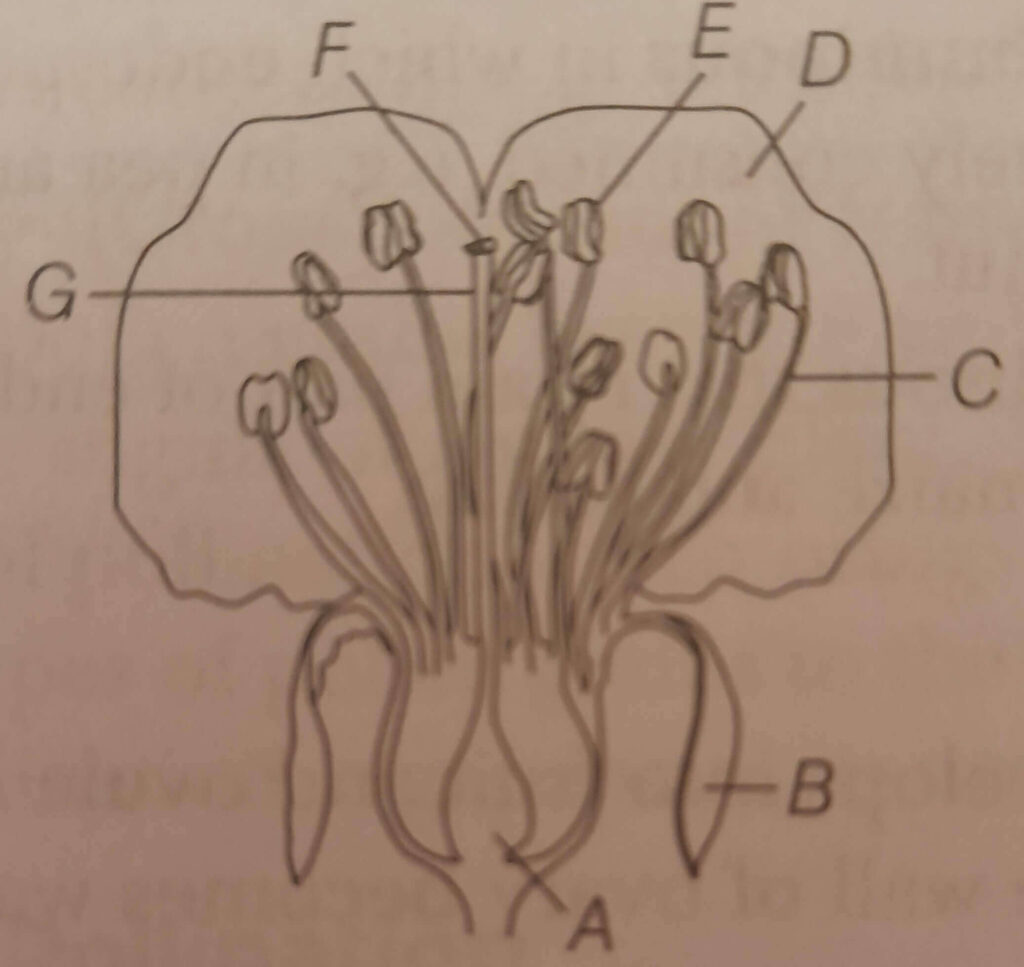
(a) A – ovary, B – filaments, C – sepal, D – petal, E – style, F – stigma, G – anther
(b) A – sepal, B – ovary, C – petal, D – filament, E – anther, F – stigma, G – style
(c) A – ovary, B – sepal, C – filament, D – petal, E – anther, F – stigma, G – style
(d) A – petal, B – anther, C – stigma, D – style, E – filament, F – sepal, G – ovary
Answer/Explanation
2. (c)
3. Proximal end of the filament of stamen is attached to the
(a) anther
(b) connective
(c) placenta
(d) thalamus or petal
Answer/Explanation
3. (d)
Proximal end of the filament of stamen is attached to the thalamus or petal and distal end is attached to the anther.
4. Identify A and B in the diagram given below.
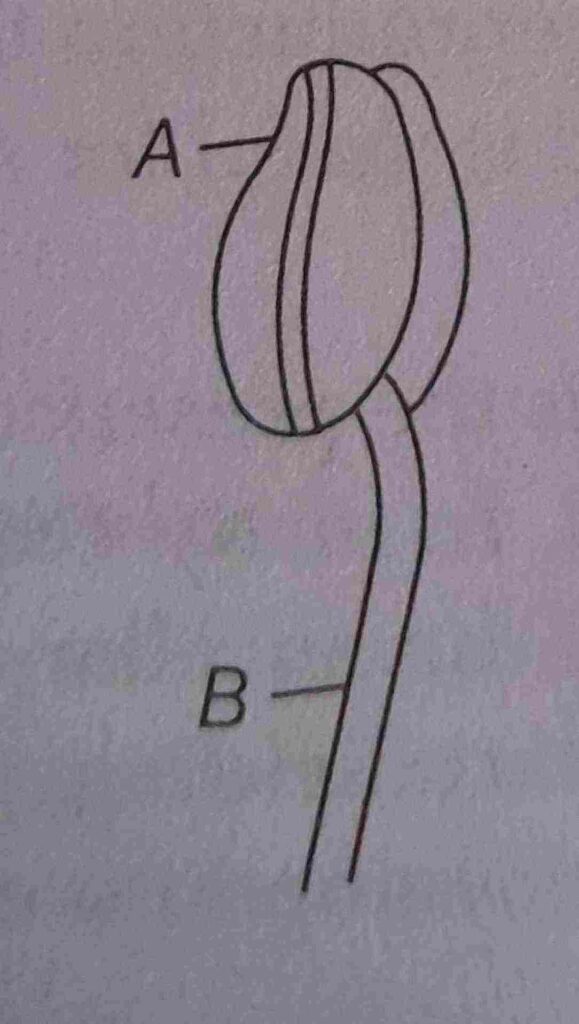
(a) A – pistil, B – stamen
(b) A – stamen, B – stigma
(c) A – anther, B – filament
(d) A – stamen, B – pistil
Answer/Explanation
4. (c)
5. A typical angiosperm anther is
(a) bilobed
(b) dithecous
(c) both (a) and (b)
(d) monothecous
Answer/Explanation
5. (c)
Billobed or Ditaceous are the same terms used for angiospermic anther lobes.
6. Identify A to D in the following diagram.
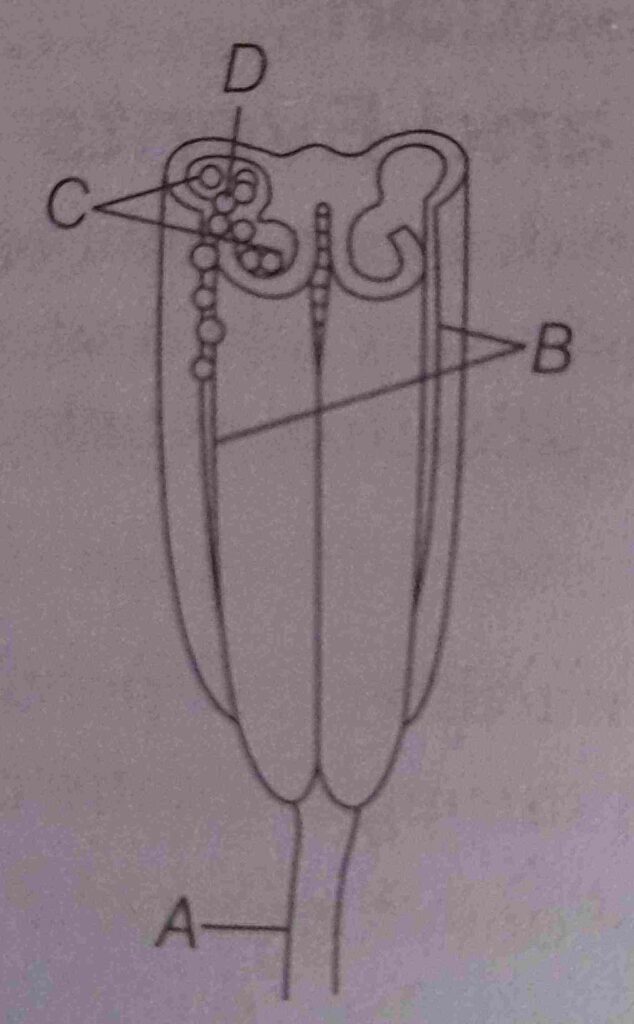
(a) A – Filament (stalk), B – Pollen sac, C – Pollen grain, D – Line of dehiscence
(b) A – Filament (stalk), B – Pollen sac, C – Line of dehiscence, D – Pollen grain
(c) A – Line of dehiscence, B – Filament (Stalk), C – Pollen sac, D – Pollen grain
(d) A – FIlament (stalk), B – Line of dehiscence, C – Pollen sac, D – Pollen grain
Answer/Explanation
6. (d)
7. The lengthwise running groove on anther which separate theca is called
(a) rupture line
(b) line of dehiscence
(c) suture of anther
(d) none of these
Answer/Explanation
7. (b)
The dehiscence which is the running groove on anther longitudinally. It seperates the theca of anther.
8. The outermost and innermost wall layers of microsporangium in an anther are respectively
(a) endothecium and tapecium
(b) epidermis and endodermis
(c) epidermis and middle layer
(d) epidermis and tapetum
Answer/Explanation
8. (d)
9. Pollen grains of different plants differ in
(a) size and shape
(b) colour and design
(c) size, shape and design
(d) size, shape, colour and design
Answer/Explanation
9. (d)
Pollens of different species are different in size, shape, colour and design because different species are adapted differently according to their environment.
10. Microsporogenesis is the
(a) development of megaspore
(b) development of pollen grain
(c) development of male gametophyte
(d) development of female gametophyte
Answer/Explanation
10. (b)
The formation of microspores inside the microsporangia of seed plants is called as microsporogensis.
11. During microsporogenesis, meiosis occurs in
(a) endothecium
(b) microspore mother cell
(c) microspore tetrad
(d) pollen grains
Answer/Explanation
11. (b)
During microsporogenesis, meiosis occurs in microspore mother cell and four haploid microspores are formed.
12. Microspore tetrad (pollen grains) is the result of
(a) mitotic cell division
(b) meiotic cell division
(c) both (a) and (b)
(d) none of the above
Answer/Explanation
12. (b)
13. The following is the diagram of TS of anther. Identify the parts labelled A, B and C.
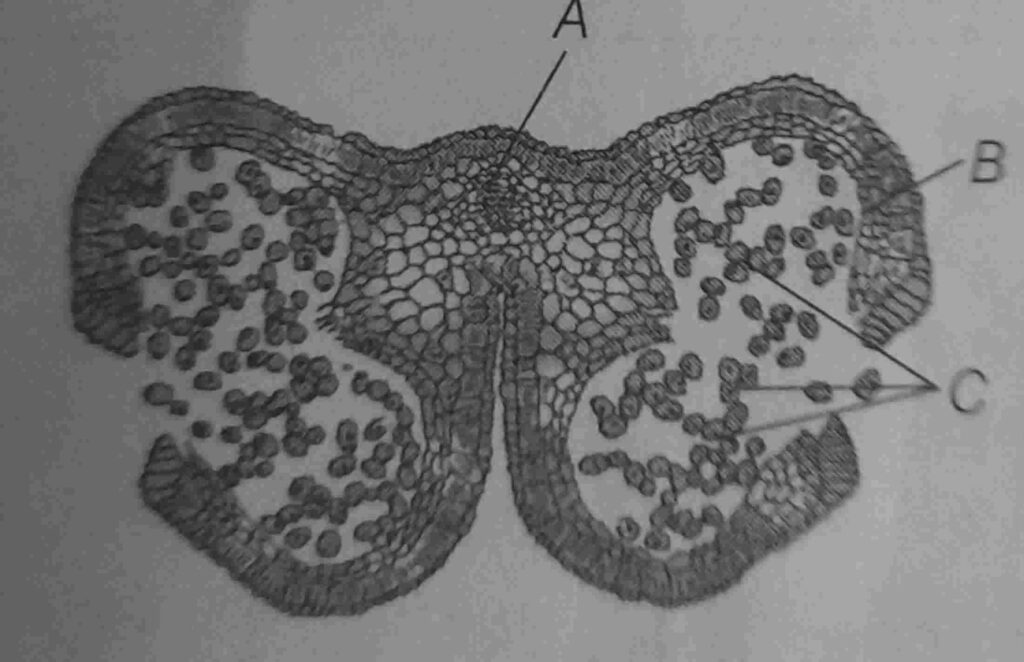
(a) A – connective tissue, B – endothecium, C – pollen grain
(b) A – endothecium, B- connective tissue, C – pollen grain
(c) A – pollen grain, B – connective tissue, C- endothecium
(d) A – endothecium, B – pollen grain, C – connective tissue
Answer/Explanation
13. (a)
14. Which of the following perform microsporogenesis?
(a) microspore mother cell
(b) pollen mother cell
(c) both (a) and (b)
(d) none of the above
Answer/Explanation
14. (c)
Microspore mother cell and pollen mother cell are the same terms which form male gametes by the process of microsporogenesis.
15. Tapetal cells are characterized by presence of dense cytoplasm and one nuclei.
(a) true
(b) false
(c) cannot say
(d) partially true or false
Answer/Explanation
15. (d)
The tapetal layer is the innermost layer of anther wall. Is composed of a single layer of cells characterized by the presence of dense cytoplasm and generally have more than one nucleus.
16. The Pollen Grain is
(a) an immature male gametophyte
(b) a mature male gametophyte
(c) partially developed male gametophyte
(d) last stage of male gametophyte
Answer/Explanation
16. (c)
Pollen Grain is partially developed male gametophyte because the rest of the development is completed on stigma when pollen grains start to germinate and produce Pollen tube having two male nuclei.
17. Pollen have two prominant walls which are …A… and …B… . Here, A and B refers to
(a) A – intine, B – protein coat
(b) A – exine, B – intine
(c) A – sporopollenin, B – intine
(d) A – sporopollenin, B – exine
Answer/Explanation
17. (b)
Pollen grain has a prominent two-layered wall. The hard outer layer called exine and inner layer called intine.
18. Which of the following statements about sporopollenin are true?
(I) Exine is made up of sporopollenin
(II) Sporopollenin is one of the most resistant organic material
(III) Sporopollenin can withstand high temperatures and strong acids
(IV) So far no in them is known to treat sporopollenin
(a) I and II
(b) III and IV
(c) I and III
(d) all of these
Answer/Explanation
18. (d)
19. Intine is made of
(a) cellulose
(b) pectin
(c) both (a) and (b)
(d) protein
Answer/Explanation
19. (c)
The inner layer of pollen grain is called intine. It is continous and thin layer made up of cellulose and pectin.
20. The function of germ pore is/are
(a) emergence of radical
(b) absorption of water for seed germination
(c) initiation of pollen tube
(d) all of the above
Answer/Explanation
20. (c)
21. Male gametophyte in angiosperms produces
(a) single sperm and to vegetative cell
(b) 3 sperms
(c) two sperms and a vegetative cell
(d) single sperm and a vegetative cell
Answer/Explanation
21. (c)
The protoplast of the male gametophyte divides mitotically to produce two unequal cells; a small generative cell and a large vegetative cell. The generative cell divides into two non motile male gametes. Thus, the male gametophyte in angiosperms produce two sperms and a vegetative cell. The vegetative cell later on grows to produce pollen tube.
22. 60% of angiosperms shed their pollens at the
(a) 2-celled stage
(b) 3-celled stage
(c) 4-celled stage
(d) 1-celled stage
Answer/Explanation
22. (a)
60% of angiosperms shed their pollens at two-celled stage and in rest 40% of pollens are shed at three cell stage, which is formed by division in generative cell mitotically.
23. Viability of pollen grains depends on
(a) temperature
(b) humidity
(c) both (a) and (b)
(d) pressure
Answer/Explanation
23. (c)
The period in which the pollen grains remain viable is highly variable. It depends on the temperature and humidity.
24. Pollen tablets are available in the market for
(a) in vitro fertilization
(b) breeding programmes
(c) supplementing food
(d) ex situ conservation
Answer/Explanation
24. (c)
Pollen grains are rich in nutrients. These are available in the market in form of tablets and a used as food supplements to improve health. In consumption has been claimed to enhance the performance of athletes and race horses.
25. Identify the type of pistil in the diagram.
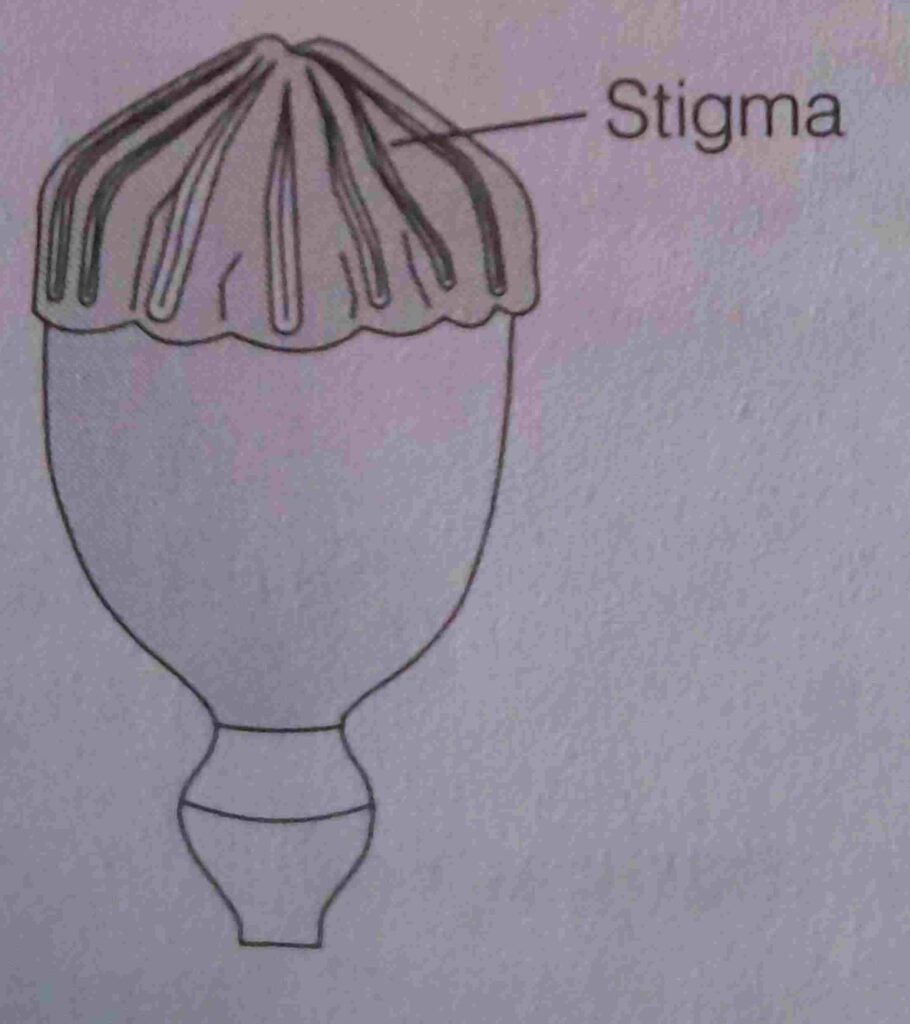
(a) multicarpellary, apocarpous
(b) multicarpellary, syncarpous
(c) multicarpellary, pistillate
(d) monocarpellary, apocarpous
Answer/Explanation
25. (b)
The diagram represents the multicarpellary pistil of the notion of this plant consists of more than one pistil showing what is multi multicarpellary condition these crystals are fused together and hence are called syncarpous.
26. Identify the various parts A to C in the given diagram of an ovule.
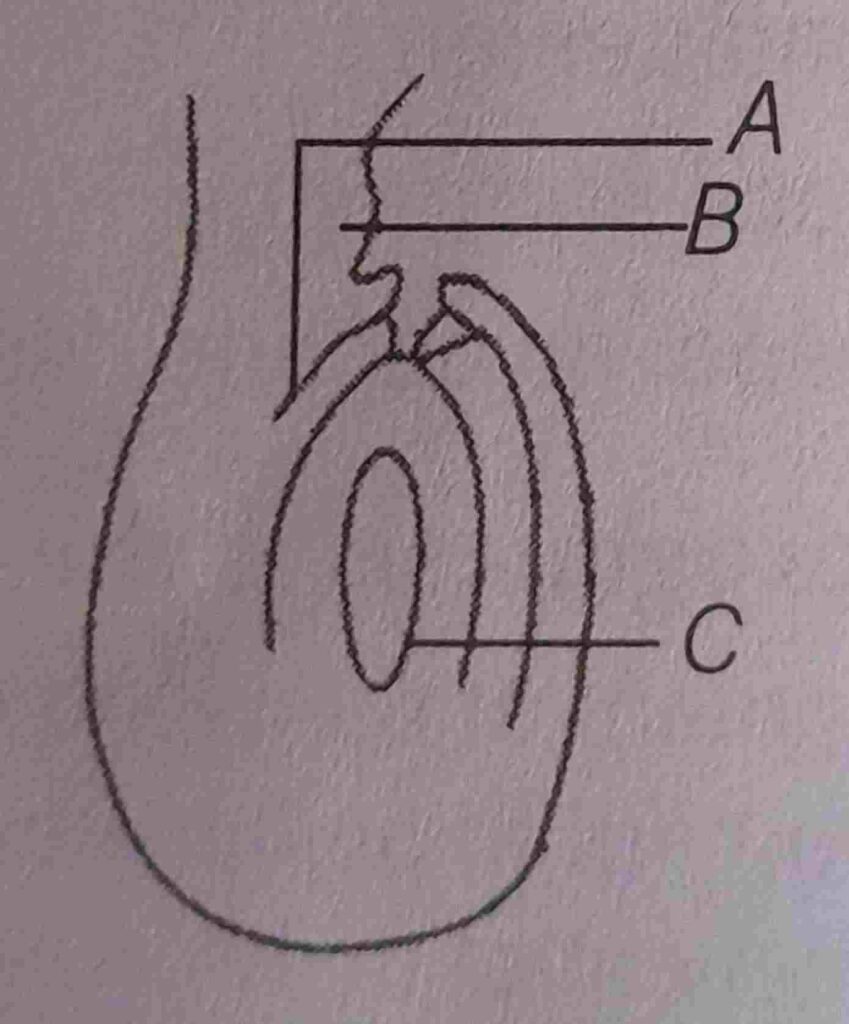
(a) A – embryo sac, B – inner integument, C – outer integument
(b) A – inner integument, B – nucellus, C – chalazal
(c) A – hilum, B – funicle, C – embryo sac
(d) A – micropylar end, B – hilum, C – inner integument
Answer/Explanation
26. (c)
27. Match the following.
| COLUMN 1 | COLUMN 2 |
| (A) Funicle | 1. Stalk of ovule |
| (B) Integuments | 2. Protective envelopes of ovule |
| (C) Chalaza | 3. Junction part of ovule |
| (D) Hilum | 4. Basal part of ovule |
(a) (A) – 1, (B) – 2, (C) – 4, (D) – 3
(b) (A) – 1, (B) – 3, (C) – 2, (D) – 4
(c) (A) – 2, (B) – 3, (C) – 1, (D) – 4
(d) (A) – 2, (B) – 4, (C) – 3, (D) – 1
Answer/Explanation
27. (a)
28. A micropyle is a
(a) small pore through which water enters
(b) small aperture where no integuments are present
(c) small pore needed for seed existence
(d) all of the above
Answer/Explanation
28. (d)
Micropyle is very essential for seed existence because through this for the water goes inside and germination takes place. Gaseous exchange also takes place through these pores. Integument in circle the nucleus except where a small opening called the micropile is organised.
29. An ovule is a
(a) differentiated megasporangium
(b) dedifferentiated megasporangium
(c) integumented megasporangium
(d) redifferentiated megasporangium
Answer/Explanation
29. (c)
An ovule is an integumented megasporangium found in angiosperms, which develops into seed after fertilization.
30. Starting from the innermost part, the correct sequence of part in an ovule is
(a) egg, nucellus, embryo sac, integument
(b) egg, embryo sac, nucellus, integument
(c) embryo sac, nucellus, integument, egg
(d) egg, integument, embryo sac, nucellus
Answer/Explanation
30. (b)
Starting from the innermost part, the correct sequence of parts in an ovule is egg, embryo sac, nucellus, integuments.
31. What is A, B and C in the given figure of an embryo sac?
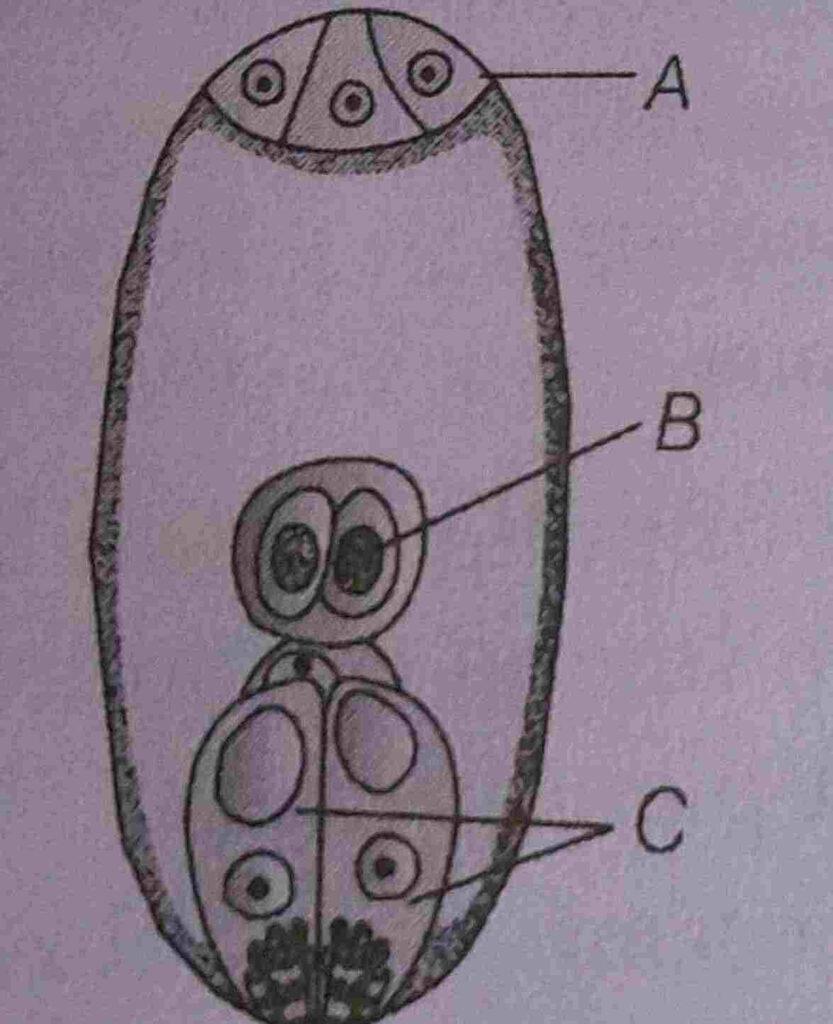
(a) A – antipodals, B – polar nucei, C – synergids
(b) A – antipodals, B – central cells, C – egg cells
(c) A – synergids, B – polar nucei, C – egg cell
(d) A – synergids, B – egg cell, C – filiform aparatus
Answer/Explanation
31. (a)
32. In majority of angiosperms
(a) egg has a filiform aparatus
(b) there are numerous antipodal cells
(c) reduction division occurs in the megaspore mother cells
(d) a small central cell is present in the embryo sac
Answer/Explanation
32. (c)
In most of the angiosperms, the megaspore mother cell divides miotically to produce 4 cells. Out of these, three degenerate and the remaining one forms the functional megaspore. This for the device mitotically and forms embryo sac.
33. In a flower, if the megaspore mother cell forms megaspores without undergoing meiosis and if one of the megaspores develop into an embryo sac, its nuclei would be
(a) haploid
(b) diploid
(c) a few haploid and a few diploid
(d) with varying ploidy
Answer/Explanation
33. (b)
In some species, the deployed egg cell is formed without reduction division and develops into an employee without fertilization.
34. In angiosperm functional megaspore develops into
(a) embryo sac
(b) ovule
(c) endosperm
(d) pollen sac
Answer/Explanation
34. (a)
In angiosperms, the functional megaspore develops into the embryo sac, which is having synergid cells, egg cell, polar nuclei and antipodal cells.
35. Which of the most common type of embryo sac in angiosperm?
(a) tetrasporic with one mitotic stage of division
(b) monosporic with 3 sequential mitotic division
(c) monosporic with 2 sequential mitotic division
(d) bisporic with 2 sequential mitotic divisions
Answer/Explanation
35. (b)
The most common type of female gametophyte in angiosperms is the monosporic embryo sac in which embryo sac develops from a single functional megaspore, while the other three megaspores degenerate.
The functional megaspore undergoes three sequential mitotic divisions and give rise to the 8 nucleate and 7 celled mature embryo sac.
36. Function of filiform apparatus is to
(a) recognise the suitable pollen at stigma
(b) stimulate division of generative cell
(c) produce nectar
(d) guide the entry of pollen tube
Answer/Explanation
36. (d)
The function of filiform aparatus is to guide the entry of pollen tube into the synergids and release of sperm cells.
37. Identify the type of cell division A to D in the following flowchart.
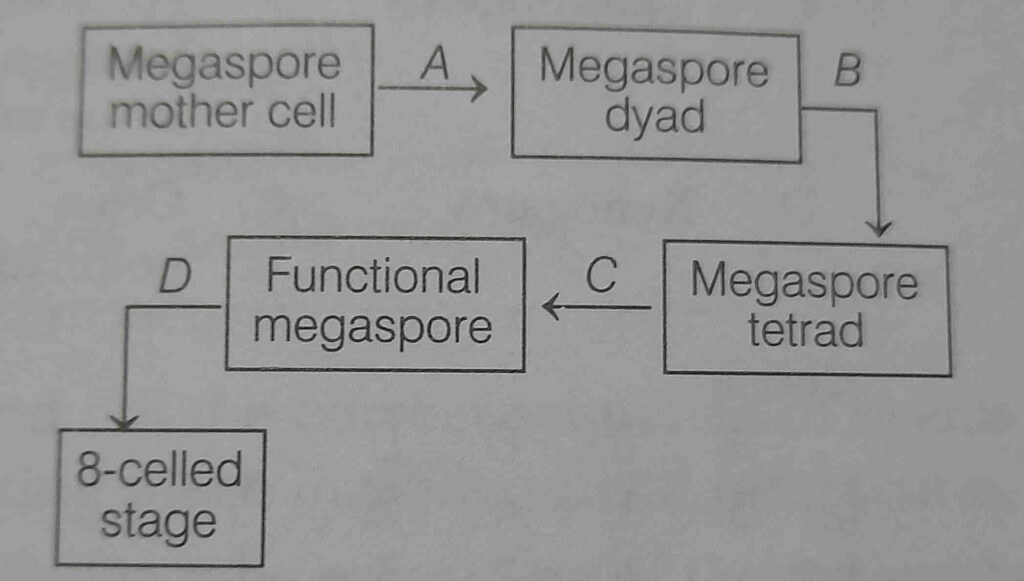
(a) A – meiosis-I, B – mitosis, C – mitosis, D – meiosis
(b) A – meiosis-I, B – meiosis-II, C – no division, D – mitosis
(c) A – mitosis, B – no division, C – meiosis-II, D – meiosis-I
(d) A – mitosis, B – mitosis, C – meiosis-I, D – meiosis-I
Answer/Explanation
37. (b)
38. From the statement given below choose the option that are true for a typical female gametophyte.
(I) it is 8 nucleate and 7-celled at maturity
(II) it is free-nuclear during the development
(III) it is situated inside integument, but inside outside the nucellus
(IV) it has an egg apparatus situated at the chalazal end
(a) I and IV
(b) II and III
(c) I and II
(d) II and IV
Answer/Explanation
38. (c)
Statement III and IV are incorrect and can be corrected as :
- Female gametophyte is present inside the nucellus
- Egg apparatus is situated at the micropylar end
39. Autogamy stands for
(a) self pollination in same flower
(b) pollination in two flowers
(c) self pollination in different flowers
(d) pollination by only one type of organism
Answer/Explanation
39. (a)
40. Match the following.
| COLUMN 1 | COLUMN 2 |
| (A) Cleistogamy | 1. Pollination in open flower |
| (B) Geitonogamy | 2. Pollination in bisexual flower which remains closed |
| (C) Chasmogamy | 3. Pollination between flowers which remain closed |
| (D) Xenogamy | 4. Cross-pollination |
(a) (A) – 3, (B) – 1, (C) – 4, (D) – 2
(b) (A) – 1, (B) – 4, (C) – 2, (D) – 3
(c) (A) – 2, (B) – 3, (C) – 1, (D) – 4
(d) (A) – 1, (B) – 4, (C) – 3, (D) – 2
Answer/Explanation
40. (c)
41. The main advantage of cleistogamy is that it insures
(a) cross-pollination
(b) seed setting even in the absence of pollinators
(c) protandry in flowers
(d) gainetogamy instead of autogamy
Answer/Explanation
41. (b)
42. Which of the following statements are true about self pollination?
(I) It is most economic method as wastage of pollen grain is minimum
(II) Genetic stability can be maintained in the progeny through self pollination
(III) Undesirable characters can be eliminated through self-pollination
(IV) Continued self pollination may result in weaker progeny
Choose the right option.
(a) I, II, IV are right and III is wrong
(b) III is right and I, II, IV are wrong
(c) I, III are right and II, IV are wrong
(d) All are correct
Answer/Explanation
42. (a)
Statement III can be corrected as:
Self pollination reduces the vigor and vitality of the plant and undesirable character cannot be eliminated by it.
43. Transfer of pollen grains from anther to the stigma of another flower of same plant is called
(a) geitonogamy
(b) chasmogamy
(c) xenogamy
(d) cleistogamy
Answer/Explanation
43. (a)
Geitonogamy transfer involves of pollen grains from anther and the stigma of different plants of the same plant.
44. Transfer of pollen grains from the anther of stigma of another flower of different plant is called
(a) geitonogamy
(b) xenogamy
(c) chasmogamy
(d) cleistogamy
Answer/Explanation
44. (b)
Xenogamy is also called cross-pollination. In this, transfer of pollen grains takes place between the anther and the stigma of different plants of same species.
45. Cross-pollination is preferred over self pollination because it results in a better offspring.
(a) True
(b) False
(c) Can’t Say
(d) Partially true or false
Answer/Explanation
45. (d)
Cross-pollination results in new varieties which are mostly better than their parents ometimes, but it may introduce undesirable characters also.
46. Match the following.
| COLUMN 1 | COLUMN 2 |
| (A) Wind | 1. Anemophily |
| (B) Water | 2. Hydrophily |
| (C) Insects | 3. Entomophily |
| (D) Birds | 4. Ornithophily |
Answer/Explanation
46. (a)
47. Autogamy can occur in chasmogamous flower if both pollen and ovules mature simultaneously.
(a) true
(b) false
(c) can’t say
(d) partially true or false
Answer/Explanation
47. (a)
48. Majority of plants use
(a) biotech agents for pollination
(b) non-biotech agents for pollination
(c) air for pollination
(d) animal for pollination
Answer/Explanation
48. (a)
Majority of the plants use biotic agents for pollination as it reduces the chances of wastage of pollen.
49. A particular species of plant produces light, non-sticky pollen in large numbers and its stigmas are long and feathery. These modifications facilitate pollination by
(a) insects
(b) water
(c) wind
(d) animals
Answer/Explanation
49. (c)
Wind pollination requires the light and non-sticky pollen grains, so that they can be transported in wind currents.
Wind pollinated flowers, often possess well-exposed stamens and large , often-feathery stigma to easily trap air-borne pollen grains.
50. Which of the following features are common to both wind and water pollinated flowers?
(I) pollen grains are long and ribbon-like
(II) stigma is large and feathery
(III) the flowers are not colourful
(IV) the flowers do not produce nectar
(a) III & IV
(b) II & III
(c) I & II
(d) II
Answer/Explanation
50. (c)
Stigma is large and feathery in wind-pollinated flowers. Pollen grains are long and ribbon like so that, it can float below the surface of water in water-pollinated flowers.
51. Pollen grain of water pollinated plants are coated by covering to prevent it from wetting
(a) mucilage
(b) cuticle
(c) exine
(d) intine
Answer/Explanation
51. (a)
Pollen grain of water pollinated plants are coated with mucilagenous covering to prevent them from wetting.
52. Wind-pollinated plants differ from insect-pollinated plants in having
(a) small petals and sticky pollen
(b) small colour petals and heavy pollen
(c) colour patterns and large pollen
(d) no petals and light pollen
Answer/Explanation
52. (d)
Wind-pollinated flowers are small and non-essential parts like petals are either absent or reduced. Pollen grains are light, small and dusty and are thus easy to be carried away by winds.
In the insect pollinating flowers, the petals are bright and scented, so that the insect gets attracted towards it.
53. Choose the mismatched option.
(a) wind – grasses – Anemophily
(b) water – Zostera – Hydrophily
(c) Insects – Salvia – Entomophily
(d) Birds – Adansonia – Ornithophily
Answer/Explanation
53. (d)
Adansonia has chiropterophilous flowers that are pollinated by fruit bats.
54. From among the given situations, choose the one which prevents both autogamy and geitonogamy.
(a) Monoecious plant bearing unisexual flowers
(b) Dioecious plant bearing only male or female flowers
(c) Monoecious plant with bisexual flowers
(d) Dioecious plant with bisexual flowers
Answer/Explanation
54. (b)
The dioecious plants bearing only male or female flowers prevent both autogamy and geitogamy.
55. Continued self pollination results in
(a) inbreeding depression
(b) outbreeding depression
(c) hybrid vigor
(d) better results of offsprings
Answer/Explanation
55. (a)
Continued self-pollination means there is continuation of genetic material to the progeny from the parents. As they are the product of same genotype of same plant. This leads to less productivity called inbreeding depression.
56. All the events from depression of pollen grain on the stigma to the entry of pollen tube in the ovule are referred to as
(a) fertilization
(b) conjugation
(c) pollen-pistil interaction
(d) singamy
Answer/Explanation
56. (c)
57. Find out the correct sequence of events taking place in pollen-pistil interaction.
(I) Pollen tube and was one of these gifts and bursts to release male gametes.
(II) Pollen tube enters ovule through micropile of ovary
(III) Pollen tube growth through this stigmatic tissue and then style
(IV) Pistol recognises the compatible pollen and accept it
(a) IV → III → II → I
(b) IV → II → III → I
(c) I → IV → III → II
(d) III → IV → II → I
Answer/Explanation
57. (a)
Pollen-pistil interaction includes recognition of compatible pollen – The pistil has the ability to recognise the right compatible pollen of the same species and to reject the pollen grains that are incompatible either of same species or of other species.
Growth of a pollen tube – The content of pollen then move into this tube.
Entry of pollen tube into the ovule – After reaching the ovary, the pollen tube enters the ovule through one of synergids at micropylar end and release male gametes.
58. Pollen grain of many species can germinate on the stigma of a flower, but only one pollen tube of the same species grows into the style.
(a) True
(b) False
(c) Can’t say
(d) Partially true/false
Answer/Explanation
58. (a)
59. Self incompatibility is a process to
(I) ensure cross pollination
(II) prevent self fertilization
(III) ensure self fertilization
(IV) genetic control for self fertilization
(a) I, II and III
(b) I, II, III and IV
(c) I, III and IV
(d) I, II and IV
Answer/Explanation
59. (d)
60. Protandry is the condition in which
(a) anthers mature after stigma
(b) anthers and stigma mature at the same time
(c) anthers mature earlier than the stigma
(d) pollens of the same flower pollen on stigma
Answer/Explanation
60. (c)
In hermaphroditic plants, a condition in which the development and maturation of male reproductive part occur before the maturation of female reproductive part to promote cross pollination and prevent self-pollination is known as protandry.
Assertion-Reason Based MCQ
Code
- Both assertion and reason are true and reason is the correct explanation of assertion.
- Both assertion and reason are true but reason is not the correct explanation of assertion.
- Assertion is true but reason is false.
- Assertion is false but reason is true.
1. Assertion In flowering plants the structure related to sexual reproduction in flowers.
Reason Various embryological processes of plants occur in a flower.
Answer/Explanation
1. (1)
Structures related to sexual reproduction in flowering plants are flowers. This is because embryological processes during sexual reproduction occur in ovary which is a part of flower.
2. Assertion Meiosis is the cell division which occurs in the sexually reproducing organisms.
Reason Meiotic cell division results into two cells having exact same genetic makeup.
Answer/Explanation
2. (3)
In meiosis, the resultant cells do not have exactly same genetic makeup due to the process of crossing over.
3. Assertion Pollen grain of angiosperm is considered as the male gametophyte.
Reason Stigma style and ovary are parts of pollen grain.
Answer/Explanation
3. (3)
Pollen grain does not contain the stigma style and ovary these are parts of the female reproductive structure of flower, i.e. gynoecium.
4. Assertion Synergids play an important role in directing the pollen tube growth.
Reason Because synergids secrete some chemotropically active substances.
Answer/Explanation
4. (1)
Synergids are part of the egg apparatus along with the egg cell. The pollen germination on the stigma to form the pollen tube. The pollen tube reaches the egg cell by chemotropism. A chemical stimulus is produced by synergids.
5. Assertion The three cells of the egg apparatus are arranged in a triangular fashion.
Reason The degenerating synergid formed the seat for pollen tube discharge in the embryo sac.
Answer/Explanation
5. (2)
The three cells in the egg apparatus are arranged in a triangular fashion as it enables the easy entry of male gametes. These enter the embryo sac within pollen tube through synergids. The synergids degenerate after the male gametes are discharged in the embryo sac.
6. Assertion Geitonogamy is genetically similar to autogamy.
Reason In geitonogamy, pollen grains come from the same plant.
Answer/Explanation
6. (1)
Geitonogamy is functionally cross pollination involving a pollinating agent, but genetically it is similar to autogamy. This is because the pollen grains come from different flowers of the same plant.
7. Assertion Cleistonogamy flowers produce assured seed set in the absence of pollinator.
Reason Cleistonogamy flowers do not open at all.
Answer/Explanation
7. (1)
Cleistogamous flowers do not open at all. This insures fertilization and consequently leads to the production of assured of seed set even in the absence of pollinators.
8. Assertion In artificial hybridisation, removal of anthers is the first step.
Reason It prevents contamination of anthers.
Answer/Explanation
8. (3)
Removal of anthers (emasculation) is done artificial hybridisation as a prevent contamination of the pistil (female reproductive structure).
9. Assertion Endosperm development preceds embryo development.
Reason It assures nutrition to the developing embryo.
Answer/Explanation
9. (1)
Endosperm is source of nutrition for the developing embryo, thus the development in the sperm takes place before the process embryogenesis.
10. Assertion There is no residual endosperm in non-albuminous seeds.
Reason The endosperm is completely consumed during embryo development.
Answer/Explanation
10. (1)
In non-albuminous seeds, the endosperm is fully consumed by the developing embryo and thus, no residue is left in such seeds.
11. Assertion An example of false fruit is mango.
Reason The thalamus also contributes to fruit formation in false fruits.
Answer/Explanation
11. (4)
Mango is a true fruit, which develops only from the ovary.
12. Assertion In apomixis, plants of new genetic variations are not produced.
Reason In apoximis, reductional division takes place.
Answer/Explanation
12. (3)
Apoximis is the type of asexual reproduction in which seeds are produced without meiosis and syngamy.
13. Assertion Parthenocarpy involves the formation of seedless fruits.
Reason Apoximis occurs without fertilisation.
Answer/Explanation
13. (2)
14. Assertion In apomixis, the plants of new genetic sequence are produced.
Reason In apoximis, two organisms of same genetic sequence meet.
Answer/Explanation
14. (4)
In apoximis, sexual reproduction is completely replaced by asexual reproduction. In this process, no new genetic sequence is formed as the progeny is genetically identical to the present.
Case-Study Based MCQ
1. Study the following figure of embryo sac in angiosperms and answer the questions that follows.
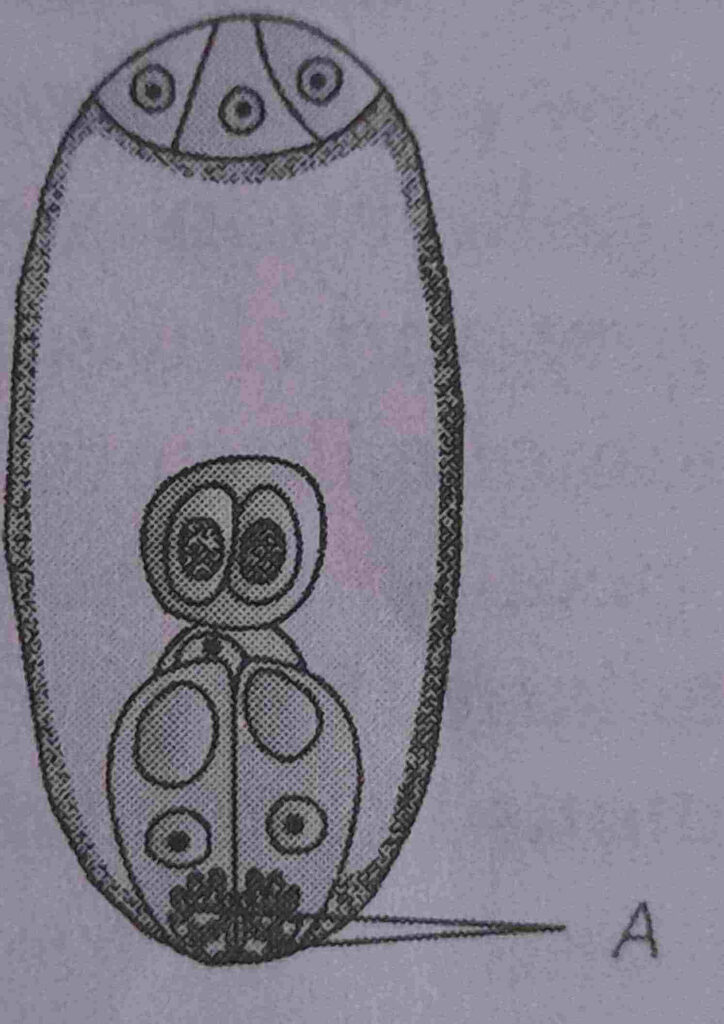
(i) Embryo sac is also called
(a) female gamete
(b) synergids
(c) female gametophyte
(d) egg of angiosperms
Answer/Explanation
Answer: c
(ii) The arrangement of the nuclei in a normal embryo sac in the dicot
(a) 3+2+3
(b) 2+3+3
(c) 3+3+2
(d) 2+4+2
Answer/Explanation
Answer: a
(iii) Antipodal nuclei in a typical angiospermic embryo sac which found towards
(a) micropylar end
(b) in the middle (polar) region
(c) chalazal end
(d) on the lateral sides
Answer/Explanation
Answer: c
(iv) What does the labelled part A do at the entrance into ovule?
(a) It brings about opening of the pollen tube
(b) It guides pollen tube from a synergid to egg
(c) It helps in the entry of pollen tube into a synergid
(d) It prevents entry of more than one pollen tube into the embryo sac
Answer/Explanation
Answer: c
2. Read the following passage and answer accordingly.
Pollination is the act of transferring pollen grains from male anther of a flower to the female stigma.
The goal of every living organism including plants is to create offspring for the next generation. One of the ways that plants can produce offspring is by making seeds which then germinate to produce new plants. Two types of flowers with their pollination is seen in plants are chasmogamy and cleistogamy.
Chasmogamous flowers have strikingly coloured petals and nectar guides/nectaries in contrast to cleistogamous flowers which are minute bud-like.
(i) Cleitogamous flowers are strictly autogamous because, they remain
(a) always open
(b) always close
(c) always fragraned
(d) brightly coloured
Answer/Explanation
Answer: b
(ii) In chasmogamy, pollination takes place in
(a) open flower
(b) closed flower
(c) large flower
(d) geitonogamy flower
Answer/Explanation
Answer: a
(iii) Advantage of cleistogamy is
(a) higher genetic viriability
(b) more vigorous offspring
(c) no dependence on pollinators
(d) vivipary
Answer/Explanation
Answer: c
(iv) Even in the absence of pollinating agents, seed-setting is assured in
(a) Commelina
(b) Zostera
(c) Salvia
(d) Fig
Answer/Explanation
Answer: a
3. Study the given figure and answer the following questions accordingly.
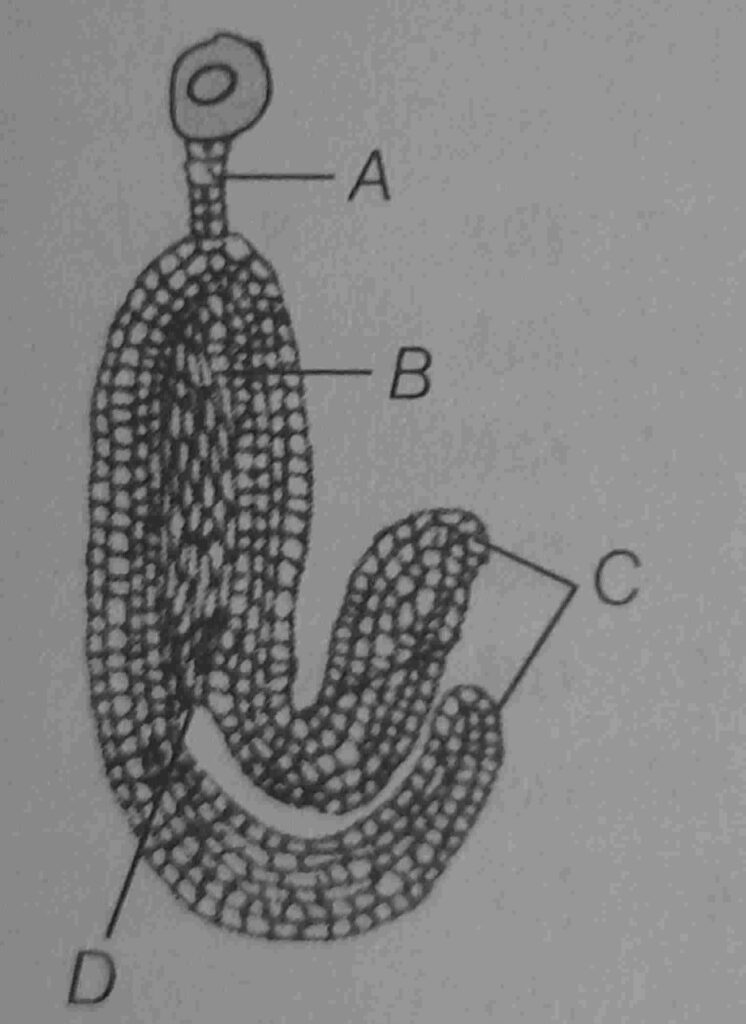
(i) The embryo in sunflower has
(a) no cotyledon
(b) two cotyledon
(c) one cotyledon
(d) many cotyledon
Answer/Explanation
Answer: b
(ii) In a cereal grain, the single cotyledon of embryo is represented by
(a) coleoptile
(b) coleorhiza
(c) scutellum
(d) none of these
Answer/Explanation
Answer: c
(iii) The ephemeral structure which anchors the embryo and pushes it into the nutritional zone of the embryo sac is called
(a) A
(b) B
(c) C
(d) D
Answer/Explanation
Answer: a
(iv) Dicot embryo consists of
(a) radicle and plumule
(b) radicle, plumule, cotyledons and sometimes endosperm
(c) radicle, plumule, cotyledons and tegmen
(d) radicle, plumule, cotyledons, tegmen and tests
Answer/Explanation
Answer: b
4. Observe the following figure of an enlarged view of a sporangium showing wall layers and answer the questions accordingly.
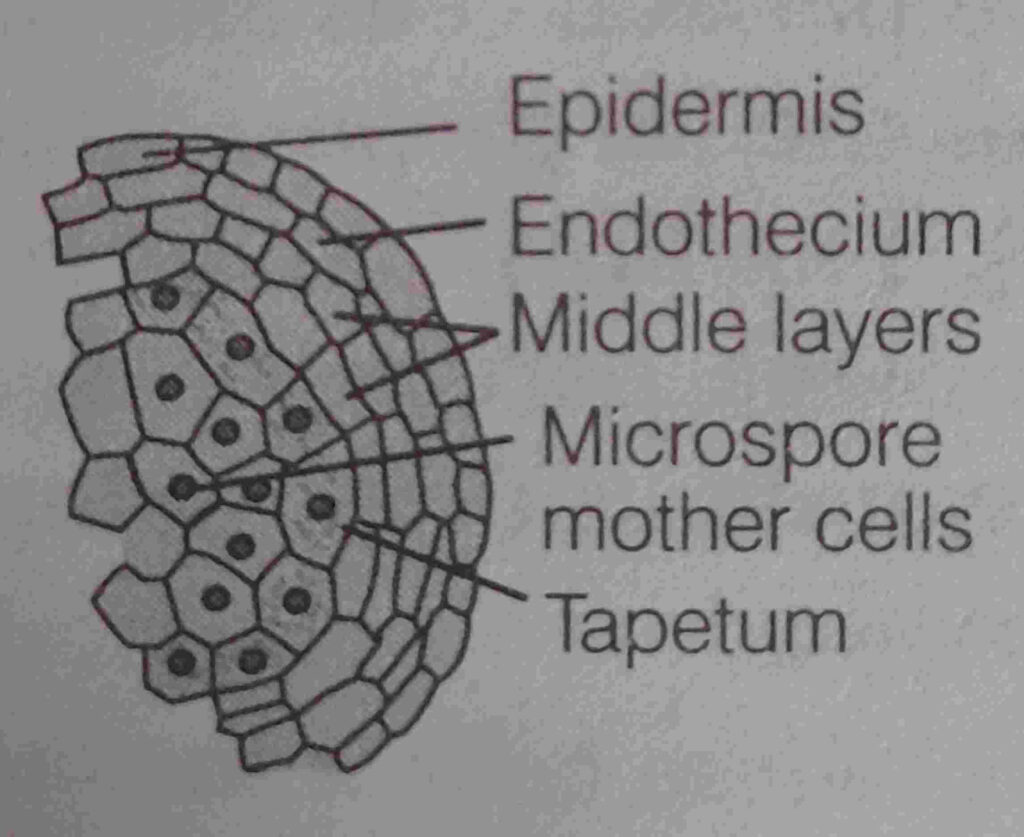
(i) The number of microsporangium present in the anther is
(a) one
(b) three
(c) two
(d) four
Answer/Explanation
Answer: d
(ii) Microsporangia develops into
(a) megagametes
(b) pollens
(c) microgametes
(d) pollen sacs
Answer/Explanation
Answer: d
(iii) Centre of each microsporangium is occupied by
(a) sporangenous tissue
(b) tapetum
(c) central tissue
(d) microspore mother cell
Answer/Explanation
Answer: a
(iv) Which of the following wall layer does not helps in dehiscence of anther?
(a) epidemis
(b) endothecium
(c) middle layer
(d) tapetum
Answer/Explanation
Answer: d
